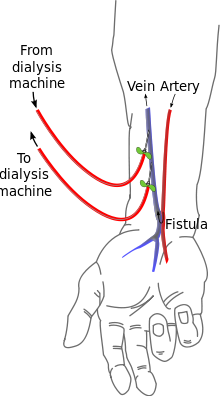Cimino fistula

A Cimino fistula, also Cimino-Brescia fistula, surgically created arteriovenous fistula and (less precisely) arteriovenous fistula (often

Structure
The radiocephalic arteriovenous fistula (RC-AVF) is a shortcut created between cephalic vein and radial artery at the wrist. It is the recommended first choice for hemodialysis access. However, after a period of usage, failures can occur. Possible causes for failure are stenosis and thrombosis especially in diabetics and those with low blood flow such as due to narrow vessels, arteriosclerosis and advanced age. Reported patency of fistulae after 1 year is about 60%, when primary failures were included.[2]
Juxa-anastomotic site (venous segment that is between 2 and 5 cm distal to the anastomotic site) is the most common site of stenosis. One of the reasons affecting the rate of stenosis could be the anastomotic angle.
Surgically created AV fistulas work effectively because they:
- Have high volume flow rates (as blood takes the path of least resistance; it prefers the (low resistance) AV fistula over traversing (high resistance) capillary beds).
- Use native blood vessels, which, when compared to synthetic grafts,[5] are less likely to develop stenoses and fail.
History
The procedure was invented by doctors
